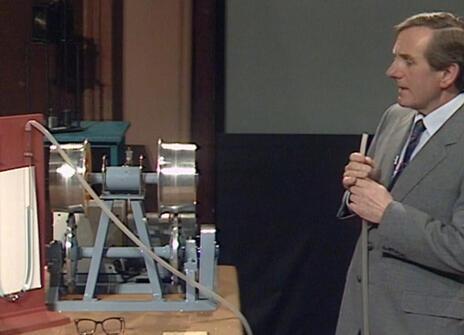Lecture 2 – Gathering momentum
From the 1983 lecture programme:
The causes of motion remained a mystery for two thousand years after the Ancient Greeks discovered the laws of equilibrium. When in 1687 Sir Isaac Newton set out the principles in what has been described as the greatest of all scientific works, the famous Principle Mathematica, he established a general theory that has formed the foundation of engineering mechanics ever since. We shall investigate the ways in which these apparently simple laws apply to motion both familiar and strange, from bows and arrows to rockets and gyroscopes. We shall see how these laws are incorporated in the flight of the Harrier and the action of other famous machines. We shall also look at important areas of machine performance, including impact, which are the subject of much current research and development.
About the 1983 CHRISTMAS LECTURES
From the 1983 lecture programme:
The world is full of movement it may be fast or slow, short-lived or long, simple or complicated. In the realms of nature, living creatures have developed astonishingly varied means of locomotion to propel themselves on land, in the sea and in the air. And in engineering, we have learned how to make machines, usually involving motion of one kind or another, for many useful purposes. All depend on the same physical basis of motion. Many famous men have contributed to our understanding of the subject, whether the motion is on the large scale as in the heavens, or on the small scale as in the atom; many others have developed machines that can move faster, further or more accurately; some have done both. In these lectures, we shall be looking at the ways in which our knowledge of the subject continues to grow. We shall also explore how it is being used to extend the extraordinary variety of machines created for our use and convenience. In the future as in the past, it will be the task of the engineer to discover new ways of doing things and to invent, design and make the new machines. All our experience suggests there are exciting prospects ahead that as yet we can hardly imagine.





